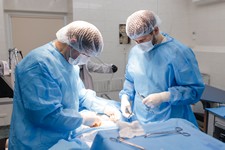

















Transvaginal removal of the uterus
What is vaginal access?
Vaginal access is one of the optimal surgical approaches in gynecology because it is minimally invasive. Unlike laparoscopy, vaginal access allows for surgeries without any incisions, providing greater cosmetic results while retaining all the advantages of laparoscopy, including rapid recovery after surgery.
Illustration during vaginal hysterectomy (removal of the uterus through the vagina):

A large number of surgeries can be performed through the vagina. These include almost all procedures for pelvic organ prolapse—of the uterus and vaginal walls in women—surgeries for stress urinary incontinence, as well as removal of the uterus, even in cases of large uterine leiomyomas. Additionally, vaginal access allows for all surgeries on the cervix.

Indications for Transvaginal Hysterectomy:
- Large fibroids (leiomyoma) with symptoms: Pain, bleeding, increased/difficult urination, etc.
- Internal endometriosis (adenomyosis) with bleeding and pain syndrome
- Recurrent hyperplastic processes, precancerous endometrial conditions (atypical hyperplasia)
- Unexplained bleeding with no effect from conservative (medical) treatment
- Chronic pelvic pain syndrome
- Early-stage oncological conditions (cervical cancer, endometrial cancer)
Procedures Possible Through the Vagina
A large number of procedures can be performed through vaginal access. These include almost all surgeries for pelvic organ prolapse (prolapse) of the uterus and vaginal walls in women, surgeries for stress urinary incontinence, and removal of the uterus, even in cases of large leiomyomas. In addition, vaginal access allows for all surgeries on the cervix.
Preparation for the Procedure
Before the procedure, several tests are needed to assess overall health:
- Complete blood count with formula
- Biochemical blood test
- Rh factor and blood type
- Coagulogram
- Blood glucose
- General urinalysis
- Consultation with a therapist + ECG, dentist consultation (to exclude any loose teeth)
- Chest X-ray (if the previous one was done a year ago)
- Consultation with relevant specialists if there are chronic diseases (e.g., endocrinologist for diabetes, pulmonologist for asthma, etc.)
Anesthesia Method for Transvaginal Hysterectomy
General anesthesia or spinal anesthesia (SMA), which does not require staying under general anesthesia.
Hospital Stay Duration: 1-2 days
What to Do With the Fallopian Tubes and Ovaries?
- Fallopian tubes: It is now clearly established that the fallopian tubes are the source of ovarian cancer in about 60% of cases. Therefore, their removal reduces the risk by half. Tubes are always removed when possible (if spontaneous pregnancy is not planned).
- Ovaries: On the contrary, ovaries are very important organs that produce the necessary sex steroids for the female body, primarily estrogen. If the ovaries are healthy and there are no clear indications for their removal, they are left intact, even in older women.
Postoperative Period
- Getting out of bed: Typically, the patient gets up 3-4 hours after surgery.
- Eating and drinking: You can start consuming light food and liquids a few hours after surgery.
- Showering: Allowed the day after surgery; bathing can resume in 3-4 weeks.
- No dressings are required.
- Limiting physical activity (sports, swimming, running): Up to 2 weeks, but otherwise you can lead a "normal life."
- Sexual activity restrictions: 1.5 months.
- Histology results: Available in 10-14 days.
- Follow-up examination: Recommended in 1.5-2 months if there are no complaints.
Conclusion
Transvaginal hysterectomy is a minimally invasive method that allows for a very quick recovery after surgery and provides the best cosmetic results (no abdominal incisions, unlike laparoscopy). This method is ideal for conditions such as significant anterior abdominal wall obesity, hypertension, and diabetes. Additionally, transvaginal hysterectomy is often part of the surgical strategy for vaginal and uterine prolapse, where other approaches are generally not advisable.
Vaginal access is minimally invasive, has good cosmetic outcomes, is associated with fewer complications, less pain, and quicker recovery, even compared to laparoscopy. Typically, there is no need for a hospital stay longer than 1-2 days after transvaginal hysterectomy.
We will discuss all questions regarding the surgery and the postoperative period during our meeting at the clinic.
You can view these and other surgeries on my YouTube channel.





